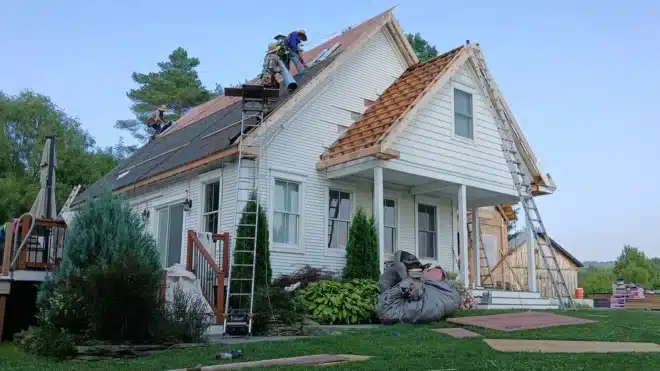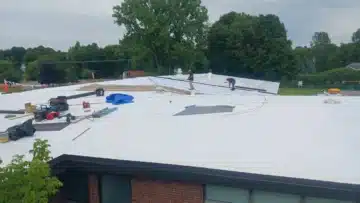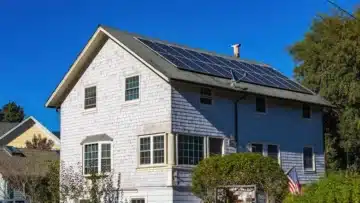Vermont’s picturesque landscapes are a dream for many homeowners, but maintaining a sturdy roof can be a real challenge. From heavy snowfall in the winter to humidity in the summer, Vermont’s unique climate brings specific roofing issues that can be troublesome. In this blog post, we’ll explore common roofing problems found in Vermont and offer practical tips on how to prevent them, ensuring your home stays protected year-round.
Understanding Vermont’s Unique Climate
Vermont’s climate can be quite varied, with significant snowfall in winter and humid summers. This section will delve into how these elements impact roofing, making it essential for homeowners to be aware of their roof’s vulnerabilities.
The changing seasons can put incredible stress on roofs. During winter, heavy snow accumulation can lead to sagging and leaks, while summer humidity can cause wood rot and mold. It’s not just about the weather; the temperature fluctuations and the natural environment also play a role. For instance, heavy rainfall can exacerbate problems like poor drainage, leading to serious roofing issues that require immediate attention.
Understanding these factors can empower homeowners to take proactive measures. By keeping an eye on the weather patterns and staying informed about seasonal changes, you can anticipate potential roofing challenges. Preparatory steps, such as ensuring proper drainage systems and maintaining adequate ventilation, can save you from costly repairs down the line. Ultimately, being proactive will help your roof better withstand what nature throws at it.
Common Roofing Issues in Vermont
From ice dams to moisture build-up, this section will outline the most prevalent roofing problems faced by Vermont homeowners and explain why they occur, allowing readers to recognize potential problems early on.
Ice dams, which occur when melting snow refreezes at the roof’s edge, are one of the most notorious issues in Vermont. These can create leaks and significant water damage if not managed effectively. But ice dams aren’t alone in causing headaches for homeowners; inadequate attic ventilation can trap heat, leading to melted snow and subsequent freezing at the eaves.
Moreover, moisture build-up often stems from poor insulation and can lead to mold growth, compromising not just your roof but your home’s structural integrity as well. Heavy rains in the spring can further exacerbate leaks, particularly if your shingles are aging or missing. The combination of these factors makes it crucial for Vermonters to be vigilant about their roofing conditions throughout the seasons.
It’s often surprising how small issues can escalate into larger, more costly ones if left unaddressed. For example, a small leak from a cracked shingle can lead to a rot in the underlying wood and insulation. Regularly assessing your roofing and addressing minor concerns can prevent these issues from piling up.
Preventing Ice Dams
Ice dams are a common concern in Vermont winters. Here, we will discuss what ice dams are, how they form, and effective strategies to prevent their occurrence.
An ice dam forms when heat escapes from the home, melting snow on the roof. This melted snow flows down to the colder eaves, where it refreezes. Creating a dam of ice that can prevent further melting snow from draining off the roof is how the trouble begins. If water builds up behind that dam, it can find its way into your home, leading to leaks and damage. Recognizing how this cycle operates can help homeowners be more proactive.
Preventing ice dams often comes down to proper insulation and ventilation. By ensuring your attic is adequately insulated, you can keep heat where it belongs. Additionally, improving ventilation can help cold air circulate in the roof area, balancing temperatures and minimizing the chances of melting and refreezing snow. This keeps your roof and home safe from the damaging effects of ice dams.
The Importance of Proper Insulation
This section will cover the crucial role insulation plays in preventing heat loss and moisture build-up, helping to stave off common roofing problems.
Insulation is your first line of defense against heat loss, which is especially important in Vermont’s frigid winters. Inadequate insulation can lead to higher energy bills and an uneven home climate. More critically, it can contribute to issues like ice dams and moisture accumulation. When your roof remains warmer, it minimizes the risk of snow melting and causing problems.
Moreover, insulation helps regulate your home’s interior climate, making it more comfortable year-round. With Vermont’s notorious weather patterns, this is a vital benefit. Homeowners often overlook the condition of their insulation, not realizing how much it contributes to their roof’s longevity. If you haven’t checked your insulation in a while, now might be the perfect time to schedule an inspection or upgrade.
Choosing the Right Materials for Your Roof
Selecting appropriate roofing materials can make all the difference. We will discuss which roofing materials are best suited for Vermont’s climate and how they can mitigate potential issues.
Choosing the right materials for your roof means considering durability, resistance to weather conditions, and lifespan. Asphalt shingles are commonly used, but they may not stand up to Vermont’s heavy snow and ice as effectively as metal roofing. Metal roofs can shed snow easily and resist both rot and damage from wet conditions.
Additionally, slate roofing can be a beautiful and long-lasting choice, perfect for steep slopes and climate challenges. While the initial costs may be higher, the long-term benefits often justify the investment. Whatever material you choose, ensuring it’s suitable for the unique demands of Vermont’s weather is key. After all, your roof should be a fortress against the elements, protecting your home while enhancing its aesthetic appeal.
Regular Maintenance Tips for Your Roof
In this section, we’ll provide a checklist for regular roof maintenance, including inspections and clean-up tips to keep your roof in optimal condition.
Regular inspections are crucial for catching small problems before they escalate. Aim to inspect your roof twice a year, preferably in early spring and late fall, to check for missing shingles, cracks, or signs of wear. Snow and ice can obscure these signs in winter, so seasonal checks can save time and trouble down the line.
Additionally, keeping gutters clear ensures proper drainage and prevents water build-up that could lead to leaks. A simple cleaning after the fall can help. Each of these steps might seem minor, but maintenance tasks contribute significantly to your roof’s endurance and effectiveness.
Don’t forget to clear debris from your roof. Leaves and branches can trap moisture and promote mold growth, while regular cleaning not only protects your roof but also maintains your home’s overall health. Remember, a little attention now can prevent large repair bills later.
Keep Your Roof Safe and Sound
By staying informed about common roofing issues and actively taking steps to prevent them, you can protect your home and keep it in great shape for years to come. Whether it’s regular inspections, proper insulation, or choosing the right materials, there are many ways to ensure your roof withstands the demands of Vermont’s climate. Remember, a little prevention goes a long way in maintaining the integrity of your home.



